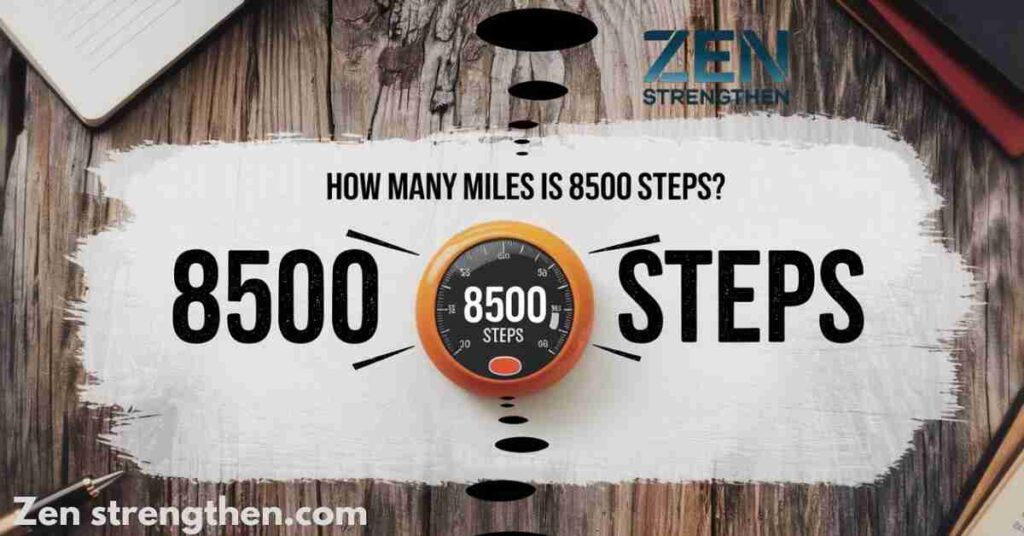Ever wondered how far you’ve really walked after hitting that 8500 steps in miles mark on your fitness tracker? You’re not alone. As more people embrace the step-counting craze, understanding step count to miles has become increasingly important.
This guide will walk you through everything you need to know about converting steps to miles, with a special focus on that 8500 step milestone. In the world of fitness tracking, steps have become the new currency of health. But what do these numbers really mean in terms of distance covered?
The Science of Step Length

Before we can answer how many miles 8500 steps equate to, we need to understand step length. Your average step length plays a crucial role in converting steps to distance.
Step length varies from person to person, primarily influenced by:
- Height
- Leg length
- Walking speed
- Terrain
On average, an adult’s step length ranges from 2.1 to 2.5 feet. However, this can vary significantly based on individual factors.
Here’s a quick reference table for average step lengths:
| Height Range | Average Step Length |
| Under 5’4″ | 2.0 – 2.2 feet |
| 5’4″ – 5’8″ | 2.2 – 2.4 feet |
| 5’9″ – 6’0″ | 2.4 – 2.6 feet |
| Over 6’0″ | 2.6 – 2.8 feet |
Remember, these are averages. Your actual step length might differ based on your unique physical characteristics and walking style.
Crunching the Numbers: Steps to Miles Conversion
Now that we understand step length, let’s tackle the math behind steps to distance conversion. The basic formula is:
Copy
Miles = Steps ÷ Steps per mile
But how do we determine steps per mile? This is where step length comes into play.
There are 5,280 feet in a mile. If we divide this by the average step length, we get the average number of steps per mile.
For example:
- With a 2.2-foot step length: 5,280 ÷ 2.2 = 2,400 steps per mile
- With a 2.5-foot step length: 5,280 ÷ 2.5 = 2,112 steps per mile
Using these calculations, we can create a rough conversion table:
| Step Length | Steps in a Mile | 8,500 Steps Equals |
| 2.0 feet | 2,640 | 3.22 miles |
| 2.2 feet | 2,400 | 3.54 miles |
| 2.5 feet | 2,112 | 4.02 miles |
| 2.8 feet | 1,886 | 4.51 miles |
So, to answer our burning question: 8500 steps typically equate to between 3.2 and 4.5 miles, depending on your step length.
Tools of the Trade: Step Conversion Calculators
In today’s digital age, you don’t need to do these calculations manually. Numerous step conversion calculators are available online and in fitness apps. These tools make it easy to convert your 8500 steps for count to miles with just a few clicks.
Some popular websites offering step conversion calculators include:
- VeryWellFit
- OmniCalculator
- Calculator.net
These calculators often allow you to input your height or step length for more accurate results.
Fitness Tracking Applications: Your Personal Step Counter

Modern fitness tracking applications have revolutionized how we monitor our daily activity. Many of these apps come with built-in step counters and conversion tools. Some popular options include:
- Fitbit: Known for its comprehensive tracking features, Fitbit devices and the accompanying app provide detailed step count information and conversions to miles.
- MyFitnessPal: While primarily a nutrition tracking app, MyFitnessPal integrates with various fitness trackers to provide step count and distance information.
- Apple Health: For iPhone users, this built-in app aggregates data from your phone’s sensors and other connected devices to track steps and estimate distance.
- Google Fit: Google’s fitness tracking app works with both Android and iOS devices, offering step counting and distance estimation features.
“The journey of a thousand miles begins with a single step.” – Lao Tzu
This ancient wisdom takes on new meaning in the age of step tracking. Every step counts towards your overall health and fitness goals.
The Power of NLP in Fitness Tracking
As technology advances, NLP-enabled APIs are making fitness tracking more intuitive and user-friendly. Natural Language Processing (NLP) allows users to interact with their fitness data using everyday language.
For instance, the OpenAI API can be integrated into fitness applications to create chatbots that understand and respond to queries about steps and distance. You might ask, “How far have I walked today?” and receive an accurate response based on your step count.
Similarly, Google Cloud Natural Language can be used to analyze user input, allowing for more natural interactions with fitness tracking apps. This technology enables apps to understand complex queries and provide more relevant responses.
Let’s dive into the nitty-gritty of step conversion calculators, explore the science behind step length, and uncover the health benefits of reaching your daily step goals. Whether you’re a casual walker or a dedicated fitness enthusiast, this comprehensive guide will help you make sense of your step count and motivate you to keep moving.
Health and Fitness Chatbots: Your Personal Fitness Assistant
Health and fitness chatbots are becoming increasingly popular, offering personalized advice and information based on your fitness data. These AI-powered assistants can help you understand your step count, set goals, and track your progress.
Some benefits of using chatbots for step conversions include:
- 24/7 availability for instant information
- Personalized responses based on your data
- Ability to understand and answer complex queries
- Motivation and encouragement to reach your step goals
Voice-Activated Assistants: Steps at Your Command
Voice-activated assistants like Amazon Alexa and Google Assistant have also joined the fitness tracking revolution. These devices can respond to voice queries about your step count and provide instant conversions to miles.
For example, you might ask:
- “Alexa, how many miles have I walked today?”
- “Hey Google, how far is 8,500 steps?”
These assistants can access data from connected fitness trackers or smartphones to provide accurate responses.
The Health Benefits of Walking: More Than Just Numbers
While tracking steps and miles is interesting, the real value lies in the health benefits of regular walking. Reaching 8,500 steps a day can contribute significantly to your overall well-being.
Here are some key health benefits of walking:
- Improved cardiovascular health: Regular walking can lower your risk of heart disease and stroke.
- Weight management: Walking burns calories, helping you maintain or lose weight.
- Enhanced mental health: Walking can reduce stress, anxiety, and symptoms of depression.
- Better blood sugar control: Regular walking can help manage and prevent type 2 diabetes.
- Increased bone strength: Walking is a weight-bearing exercise that can help prevent osteoporosis.
- Improved balance and coordination: Regular walking can reduce the risk of falls, especially in older adults.
| Activity Level | Steps per Day | Approximate Miles | Calories Burned (150 lb person) |
| Sedentary | < 5,000 | < 2.5 | 100 – 200 |
| Low Active | 5,000 – 7,499 | 2.5 – 3.5 | 200 – 300 |
| Somewhat Active | 7,500 – 9,999 | 3.5 – 5 | 300 – 400 |
| Active | 10,000 – 12,499 | 5 – 6 | 400 – 500 |
| Highly Active | ≥ 12,500 | > 6 | 500+ |
Setting and Achieving Daily Step Goals
Now that we understand the value of walking and how to convert steps to miles, let’s talk about setting and achieving daily step goals.
- Start where you are: Use a pedometer or smartphone to track your current daily steps.
- Set realistic goals: If you’re currently at 4,000 steps, aim for 5,000 to start.
- Gradually increase: Add 500-1,000 steps to your goal every week or two.
- Make it fun: Challenge friends or join online step-counting communities for motivation.
- Use reminders: Set alerts on your phone or fitness tracker to remind you to move.
Remember, the widely-known goal of 10,000 steps (about 5 miles) isn’t a magic number. The key is to increase your activity level gradually and consistently.
Strategies to Boost Your Step Count
Reaching your daily step goal doesn’t have to be a chore. Here are some creative ways to increase your step count:
- Take the stairs instead of the elevator
- Park farther away from your destination
- Have walking meetings or phone calls
- Use a treadmill desk while working
- Take a post-dinner walk with family or friends
- Dance while doing household chores
“The real voyage of discovery consists not in seeking new landscapes, but in having new eyes.” – Marcel Proust
Apply this philosophy to your daily routine. Look for opportunities to add steps in your everyday activities.
The Future of Step Tracking: NLP and AI
The future of step tracking looks exciting, with advancements in NLP and AI promising to make fitness tracking more intuitive and personalized than ever.
Research publications in health technology highlight the potential of these technologies:
- Improved accuracy in step counting and distance estimation
- More personalized fitness recommendations based on individual data
- Enhanced user engagement through natural language interactions
- Integration of step data with other health metrics for comprehensive health monitoring
NLP frameworks like spaCy and NLTK are being used to develop custom applications that can understand and respond to complex fitness queries. This could lead to more sophisticated interactive health platforms that provide detailed insights based on your step data and overall health profile.
Conclusion
Whether you’re aiming for 8,500 steps or setting your sights higher, remember that every step counts towards better health. Understanding how your steps translate to miles can provide motivation and context for your daily activity.
From basic step conversion calculators to advanced NLP-enabled APIs, technology is making it easier than ever to track and understand our physical activity. As we move forward, these tools will only become more sophisticated, offering even more personalized insights into our health and fitness.
FAQ,s
How many miles is 8500 steps?
On average, 8,500 steps equate to approximately 4.25 miles, depending on individual step length.
What is the average step length for adults?
The average step length for adults ranges from 2.1 to 2.5 feet, which can affect the distance calculation.
Can I use my smartphone to track steps?
Yes, many smartphones come equipped with health apps that can track steps and convert them to miles.
Are there any apps that can help with step conversion?
Yes, apps like Fitbit and MyFitnessPal offer features to convert steps to distance and track overall fitness.
How accurate are step conversion calculators?
Step conversion calculators provide estimates based on average values, so individual results may vary.
What health benefits come from walking regularly?
Regular walking can improve cardiovascular health, aid in weight management, and enhance mental well-being.
How can I set a daily step goal?
Setting a daily step goal involves assessing your current activity level and gradually increasing it based on your fitness objectives.
Disclaimer
“This article” is intended for general informational purposes only and does not address individual circumstances. It is not a substitute for professional advice or help and should not be relied on to make decisions of any kind. Any action you take upon the information presented in this article is strictly at your own risk and responsibility!

Jhon Wick is a seasoned writer in the fitness niche, dedicated to sharing expert advice and the latest trends. With a passion for health and wellness, Jhon offers practical tips and inspiration to help readers achieve their fitness goals and stay motivated.







